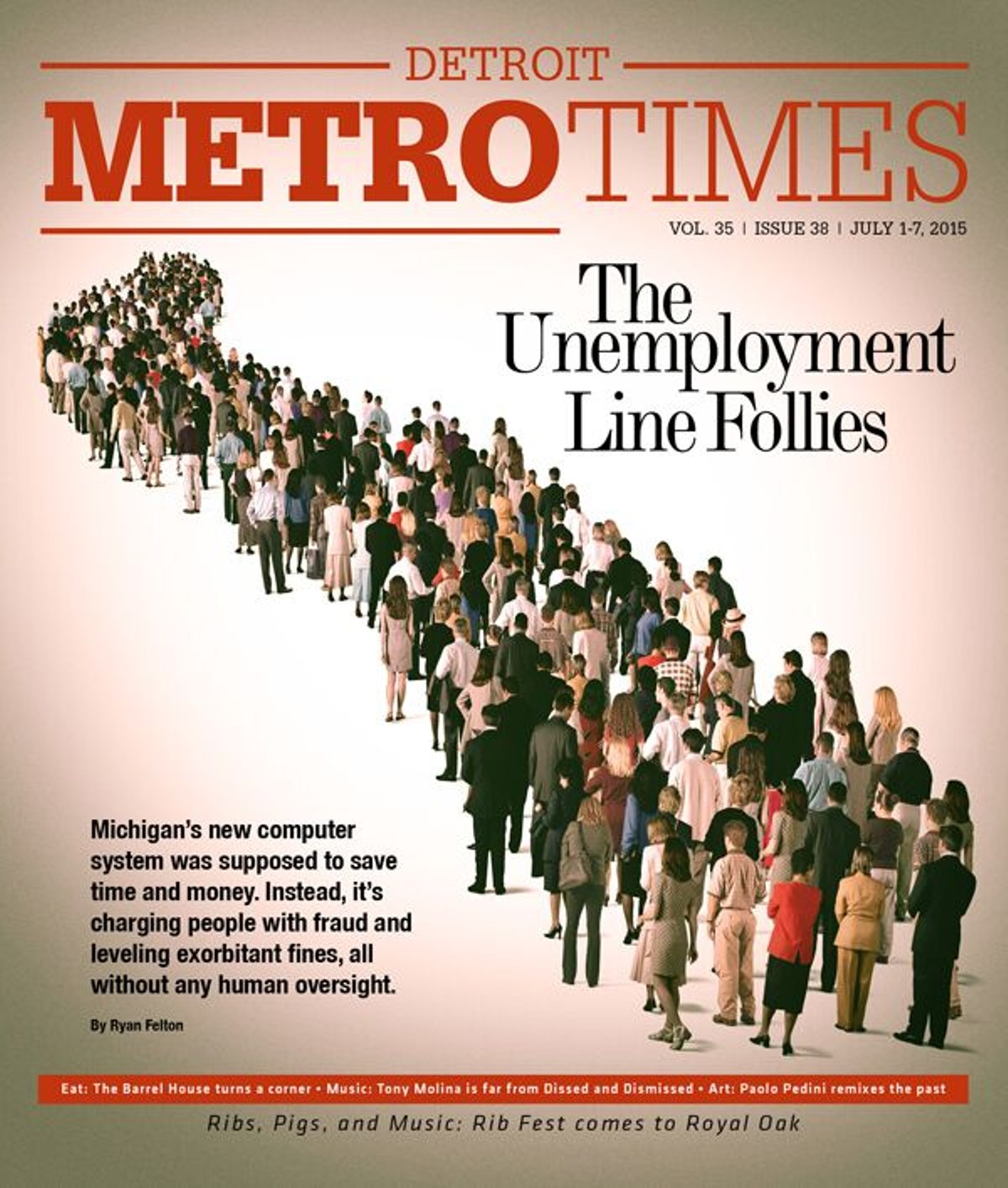Inside the lobby of a nondescript building situated in a strip mall along Eight Mile Road, just outside Detroit, a tall man emerges from behind a door. Like a nurse calling for a patient at a doctor's office, he bellows a name.
Attorney David Blanchard stands, picks up his briefcase, and begins to stroll down the hall, past a series of unremarkable offices that double as courtrooms. Beside him is a 50-something woman who works as an information technology specialist. A representative from the woman's employer trails behind.
The woman, who'd prefer to be known as "Sue," is set to meet Administrative Law Judge Raymond Sewell, one of a cast of characters who routinely decides the fate of a parade of people that come through his doors. Sewell and his colleagues take their jobs seriously; they're an affable bunch, which is perhaps surprising, given their line of work: As judges who work for the Michigan Administrative Hearing System, they routinely settle the mundane — tax bills, compensation issues, and disputes over unemployment benefits.
But really, the boring can be earth-shattering for the folks who await their decisions. These administrative law judges dive into hefty problems, giving their cases as much attention as you'd find in the highest courts in the land. They take notes, deliver grand pronouncements, and hand down life-altering decisions.
Sewell's office is decorated with a photo of President Barack Obama and emptiness otherwise. The 78-year-old judge is a former Macomb County prosecutor. He's a lanky gentleman who speaks with a deep, gentle croon.
The reason Sue has taken off work to meet with the judge on an unpleasantly hot and humid day in June is because the state of Michigan believes she's a criminal.
It began like this: In October 2014, Sue filed for unemployment insurance after being laid off from a contracted IT position. Before the economy self-destructed in 2008, she worked at Ford. Today, like many, she relies on contractual employment opportunities. It was the understandable decision to file for unemployment that led her into Sewell's world. According to the state, Sue has misrepresented how much income she earned during periods she claimed to be unemployed.
State records showed she collected a check from the beginning of January 2014 until she was laid off in October.
But that's not the case, according to Sue. It's indisputable when the job began. It was Valentine's Day.
"I remember," she later tells me. "I brought cookies."
Michigan's Unemployment Insurance Agancy is adamant, however, saying its records indicate Sue has received about $2,200 in benefits from the unemployment insurance fund that, according to the agency, she illegally obtained. And because of the alleged fraud, the state says she is required to pay $9,000 in penalties — combined with the $2,200, she's looking at a bill of more than $11,000.
That would freak just about anyone out. And Sue is freaked.
Blanchard, with 10 years of experience handling similar cases, is able to quickly pinpoint an error. For whatever reason, he says, the state's computer system, wrongly, took the lump sum she earned in the first quarter of 2014 (Jan. 1 to March 31), and divided that figure by 13, before spreading the uniform dollar amount across each week.
He hands Sewell a spreadsheet illustrating the error. The representative appearing on behalf of Sue's firm confirms there's no record of her starting work before Feb. 14.
The look on everyone's face in the room presents the same question: What's going on here?
No one from the UIA was present, but Blanchard posits the error is yet another screw-up generated by the UIA's software program used to detect fraud.
Sue appealed the claim, he says, but it fell on deaf ears. Literally.
"[The appeal] was not considered by a human person," says Blanchard.
"You're saying the agency used the computer to determine fraud," Sewell responds.
Yes, without any human oversight, a machine had determined Sue committed fraud. Sewell promptly dismisses the fraud claim, saying Sue was legally entitled to unemployment benefits.
Given those circumstances, some of Sewell's colleagues are baffled by what they've seen lately.
Since 2011, under Republican Gov. Rick Snyder, the state has spent tens of millions of dollars to slowly implement a computer software program that handles applications filed with the UIA. The effort to curb waste is consistent with a vision posed by Snyder of operating government with a business-minded attitude.
The program — called MiDAS — detects possible fraud by claimants.
The problem, says Blanchard, who represents several plaintiffs in a recently filed federal lawsuit that challenges the UIA's alleged "robo-adjudication" system, is that apparent lack of human oversight. MiDAS seeks out discrepancies in claimants' files, according to the lawsuit — and if it finds one, the individuals automatically receive a financial penalty. Then, they're flagged for fraud.
"The system has resulted in countless unemployment insurance claimants being accused of fraud even though they did nothing wrong," the suit says.
The net effect, Blanchard asserts, is that Michigan now has a system in place that criminalizes unemployment. It's a process that, contrary to its stated intention, is creating fraud, rather than eliminating it — a MiDAS touch, if you will, where the state gets the gold: The program has been a windfall for Michigan, collecting over $60 million in just four years.
The state has also gloated about the software's progress in detecting significant amounts of fraudulent claims, but what officials don't seem to grasp is the enormity of the situation, according to administrative judges and attorneys who are routinely involved with fraud cases.
Claimants can be issued a warrant for their arrest, Michigan can garnish their wages and federal and state income taxes, and some succumb to bankruptcy. The number of claimants who have faced those circumstances for being falsely accused of fraud is entirely unknown, but it's clearly an emerging contingent.
That's not to say legitimate claims aren't being brought. But administrative judges, UIA workers, and attorneys say bogus fraud charges are being levied by the state with greater frequency.
So instead of protecting some of the state's most vulnerable residents, they say, the UIA has ushered in a disaster. And those affected by the process, buried in debt, have been pushed to the brink — financially and emotionally. A couple have even attempted suicide in the wake of the "decisions" by MiDAS.
Blanchard says the system is such a mess that he tells people not to apply for unemployment unless their case is a slam dunk.
"People who are clearly eligible are being accused of fraud on a regular basis and it wrecks their lives," he says.
For Sue, the aftershock of being accused of fraud has left an everlasting mark: She never plans to file for unemployment again.
Now, many working-class individuals like her won't either.
'Supports Gov. Snyder's commitment'
The story of Sue and millions across the U.S. should come as no surprise. The economy tanked several years ago and a sharp increase in unemployment applicants followed.
As a result, the Unemployment Insurance Fund — a somewhat complex system that operates off revenue generated by both the state and federal government — began making a significantly higher amount of overpayments to ineligible claimants.
In Michigan, the U.S. Department of Labor found in 2009 that the state's UIA paid an estimated $3.7 billion in unemployment benefits. Of that, the UIA overpaid an estimated 7.2 percent — or $266.4 million, the labor department said.
In 2010, the UIA issued a request to identify technology that could improve the system. Officials said they would tap federal money, generated by the stimulus package approved under Obama for the project, in an attempt to follow suit with the federal government's efforts to curb overpayments.
The ways in which states decided to address unemployment insurance waste varied, according to William Hays Weissman, a shareholder of Littler Mendelson office in Walnut Creek, Calif., who has written extensively on the issue, meaning there wasn't a uniform model to adhere to.
But the desire in Michigan to grapple with UI overpayments attributed to fraud wasn't heightened until Snyder's election in 2010.
In one of his first moves in office, Snyder signed a law that cut Michigan's unemployment benefits from 26 weeks to 20, leading the state to pay "fewer weeks than any other state" at the time, the New York Times observed.
Democrats in the state House and Senate howled, painting the move as an attempt by Republicans to attack the working class and the poor.
But what practically no one realized was that Snyder also greenlighted a bill to purchase software to address unemployment overpayments and fraudulent claims.
A complete overhaul of Michigan's 30-year-old UI system carried a price tag in the tens of millions of dollars.
The Michigan Chamber of Commerce, the largest lobbying group for business in the state, took notice. And it delivered full-fledged support of the endeavor.
Saying the state's UI fund was in a "crisis," a representative from the chamber used the labor department's 2009 figures on overpayment claims — that 7.2 percent of "waste and fraud" — and twisted them to bolster support for the software.
"Based on prior federal data, we know that approximately 30 percent of all overpayments are made to people who were working while fraudulently collecting UI benefits, meaning approximately $143 million was paid to individuals who were working while fraudulently collecting UI benefits in 2009," the chamber executive testified.
That wasn't the truth, however. When the nonpartisan House Fiscal Agency examined the bill, they also addressed the 7.2 percent figure cited by the labor department, and noted only 0.7 percent was attributed to fraud, an estimated $25.9 million.
By implementing new software, "the state may save some unknown portion of those overpayments and fraudulent claims," the HFA concluded in its analysis.
Not exactly inspiring stuff. But with Snyder's signature, the transformation of the Michigan UIA quickly commenced and became a lucrative opportunity for several contractors.
In July 2011, the state awarded Greenwood Village, Colo.-based Fast Enterprises a $47 million contract to begin work on the MiDAS project, a deal officials pegged as a modernization of the state's unemployment insurance infrastructure.
According to the contract, the goals of the MiDAS system were to improve customer service, eliminate manual, labor-intensive process, increase data accuracy, and reduce costs of operations, "specifically in removal of redundant operations, elimination of data errors, detection and elimination of fraud [where possible], and the introduction of streamlined processes."
At the time, the UIA fell under the Department of Licensing and Regulatory Affairs (LARA). (Today, it's part of the newly created Department of Talent and Economic Development.) The unemployment system overhaul was meant to align with Snyder's vision for LARA, according to a National Association of State Chief Information Officers award application for MiDAS filed by the state last year. The vision of LARA procured by Snyder, the application notes, is to reinvent government as "customer driven and business minded."
Meanwhile, the UIA awarded an $18 million bid to Chicago-based CSG Government Solutions to provide a "full-time, onsite project management [team] to oversee a comprehensive and complex rewrite of Michigan's current Unemployment Insurance Systems," according to the contract. By September, Michigan purchased the Waterford-based On-Point Technologies case management product for $2 million as a temporary stopgap to "detect and recoup money owed to agencies" until MiDAS was fully operational.
The state also awarded a $14 million contract to SAS Analytics to implement fraud detection software that would be integrated into MiDAS. The purpose was a simple one, SAS wrote in a press release announcing the contract: It will "fight fraud, waste and abuse in the state's unemployment insurance and food stamps program."
Finally, in October 2013, the MiDAS software became fully operational. Its rollout coincided neatly with a reduction in the UIA's staff by roughly one-third. It was a curious decision, especially given the circumstances of the situation: The agency was still bogged down with a mountain of claims stemming from the economic recession.
"While the rollout had its challenges," Fast Enterprises wrote last year, "all-in-all [it] went smoothly — especially when compared to similar rollouts of benefits systems in other jurisdictions."
Supporters of the move said it was the right choice. For years, they said, the Michigan UI system was outdated, generating a backlog of cases and long lines.
But it hasn't been entirely smooth for everyone. The long lines might have disappeared, but they've been replaced by a cascade of computer glitches.
'Whole point' is to prevent hunger, loss of home
There are a few typical reasons why you'll file for unemployment: You've been discharged, laid off, or you quit.
With the implementation of MiDAS, filing now requires you to sign up for the so-called MiWAM Web portal, essentially a website created for claimants to manage their unemployment benefits.
If MiDAS makes a fraud determination, the process has the effect of a steamroller.
First, you'd lose access to a legal advocate — similar to a defender appointed in criminal cases. Michigan is one of few states in the U.S. that provide such a program.
"With that happening, individuals are faced with either going out into the market trying to obtain legal representation," says Anthony Paris, attorney for the Detroit-based Sugar Law Center, which represents claimants in fraud cases and is also an institutional plaintiff in the pending federal lawsuit. "And usually, we're their first call, as far as that goes."
Paris says calls to Sugar Law over alleged fraud claims increased after MiDAS was implemented — and they've skyrocketed ever since the federal complaint was filed in April. The attorney says his office has a list of about 250 individuals who have received questionable fraud allegations from the state over their unemployment benefits. With such an influx of individuals seeking help, the law center's short staff has been bogged down.
The software also retroactively seeks out discrepancies going back six years, Paris says, potentially dredging up fraud charges for individuals who could be on the job again.
Things only get more stressful from there. After a fraud determination has been made, a questionnaire is sent from the UIA. If you don't fill it out — some claimants have missed the notification in their MiWAM account (more on that later) — the state presumes fraud has undoubtedly been committed.
If you do fill it out, and the state still believes you've committed fraud, you have 30 days to appeal, which then can lead you into the courtroom of an administrative judge.
Meanwhile, the state stops paying you unemployment benefits and can immediately start collecting garnished wages and state and federal income taxes.
"The whole point of the unemployment system is to prevent people from going hungry, prevent people from losing their homes simply because they've lost their job; that there is some kind of bridge money there where the lights can stay on and the bills can get paid even while you're looking for the next job," says Blanchard. "That system is undermined automatically and upfront if people are denied those benefits until they prove beyond a reasonable doubt that they're entitled to them."
That was the predicament plaguing Kevin Grifka.
The 37-year-old Chelsea resident works as an electrician, a job that frequently entails layoffs and unemployment benefits. Before MiDAS was implemented, Grifka says he never had a problem.
Last summer, Grifka was laid off. He applied for and received unemployment benefits for three months before returning to work.
Weeks went by, and then in December, he received a letter saying he owed nearly $13,000 in restitution and penalties. The notice said he was actually being paid during the time he claimed to be laid off.
He notified the Michigan Works! office in Lansing, which told him everything should be squared away. From there, his situation was conveyed to the UIA. The agency's response was a shell shock: He missed the deadline to appeal his fraud claim.
Immediately, the state garnished his federal income tax return. All of it.
"It was about $8,500," Grifka says.
The fraud claim couldn't have come at a worse time — it was the holiday season and Grifka had four kids at home.
"To see your wife cry at night is not cool," Grifka says. "The kids, I never told them, they're too young to even realize, but you look at four months, five months almost, on the phone dealing with people trying to get basically nowhere, and it's very disturbing."
The issue Grifka faced was similar to Sue's. The agency took his earnings in one quarter and divided it equally across 13 weeks. Unbeknownst to him, MiDAS construed that to mean Grifka committed fraud for not reporting income the software thought he earned.
In other words, it created the fraud out of thin air.
"Every time you turn around you're thinking, 'Are they going to tie your house to it?'" says Grifka. "Five months of pretty crazy agony."
Grifka was lucky to get a notice in the mail. In some instances, when applicants sign up for MiWAM, they may receive significant notifications on potential fraud through the Web portal only, not mail.
For anyone like Grifka, who simply went back to work, the scenario could be devastating. For weeks, they could be receiving notifications they've allegedly committed fraud and not even realize it.
Paris says the Sugar Law Center has seen plenty of examples like that.
"They had no reason to check that after they'd been collecting benefits properly for the entire time," he says.
Despite the issues, MiDAS has achieved its stated purpose: cut costs and bring in savings.
Collecting methods abound
The state has projected MiDAS will save the UIA roughly $2 million annually, but it's the amount of overpayments and fraud penalties the system has seized that is most remarkable.
Since last October, MiDAS has collected over $63 million in overpayments. Comparatively, in the entire year of 2010, the state collected $27.3 million. Attorneys involved in the fraud hearings raise a pointed question, though: Is the state collecting money over legitimate fraud?
"There's something corrupt about a system that takes the unemployed and makes the system overexpansive," asserts John Philo, executive director of the Sugar Law Center. "And I think it's intentionally over-expansive knowing that X number of people won't fight it, will just go along with it — and the number that do fight it, any potential there is made up by the revenue gain."
And using authority granted under state law signed by Snyder, the UIA has collected nearly $2.65 million by automatically garnishing wages.
If the state doesn't garnish wages, it may attempt to collect from individuals forced into filing for bankruptcy because of the drastic penalties assessed on fraud claims. The Michigan Attorney General's office routinely intervenes in bankruptcy proceedings of individuals attempting to discharge the fraud penalties. In May alone, the state filed almost two dozen adversary proceedings.
In one petition, a Michigan resident sought to discharge over $6,100 in restitution and $17,600 in alleged fraud penalties — over $23,000 — but the state wasn't having it, even though the petitioner had already paid $7,600 back to cover restitution.
The attorney for the claimant, Mark McLoughlin, fired back in court, saying the state has wrongly pursued the repayment. His remarks echo the allegations of the federal lawsuit that paints a picture of an unemployment system in disarray.
McLoughlin, a bankruptcy lawyer for over three decades, wrote his client "cannot be shown to have committed fraud" because the state is "complicit in maintaining a system of reporting that does not allow a claimant a fair opportunity to understand and report the information being requested."
During his career, he says he'd receive one client per year who was stuck with a debt to the unemployment agency.
Then, within the last year, "there's just a flood of these things," McLoughlin tells me. "I have probably 20 in the last two or three months."
McLoughlin says it's readily apparent it's because the state has automated the unemployment system.
For example, he says some clients have explained they'll be out of work for a couple of months, then land work at a part-time job, with only five to 10 hours of work per week. They'll call to certify with the agency on their weekly report, but an automated computer will greet them with a question of whether they're employed, and if so to please press 1 now.
Is that part time, full time? Who knows?
"Next thing you know, two years later, the agency is saying, 'You lied to us,'" McLoughlin says. "Well, he wasn't even talking to a human being. Secondly, I wasn't really given a fair option as to what my situation was."
When the UIA does collect financial penalties, that money is deposited into the Penalty and Interest Account of the agency's Contingent Fund. For years, that account was used for administrative purposes of the UIA.
The revenue stream of the account has grown dramatically since the unemployment system was overhauled. In 2011, the account had a balance of $3.1 million; as of last October, that figure had ballooned to $68.8 million.
Under a law signed by Snyder last month, that money can be put to a broader use: The penalty and interest account is now available solely for the governor's Department of Talent and Economic Development.
The purpose? To create new workforce training programs.
'A corrupt system'
Attorneys and claimants are not the only ones bashing the system. Administrative judges employed by the state to hear unemployment benefit claims have concerns too.
"The system, from my perception ... it's an inhumane, automated monstrosity that treats citizens of this state who are the most vulnerable as if their criminals," says one judge who spoke on the condition of anonymity.
The cases of Sue and Grifka are pretty easy to understand: The software goofed and wrongly accused them of fraud. There are plenty of other instances that are less obvious, though, and the judge remembers one particularly egregious case, one so convoluted it captures the full scope of issues observers have witnessed.
In this story, the judge was dealing with a woman from Detroit who worked for a temp agency.
The woman received an assignment in Sterling Heights, a monumental task for a Detroit resident without access to a vehicle. Nevertheless, she persisted by mounting the unreliable bus systems in the region, managing to be late 13 times in the five months she was employed, and missing work only five times.
How employees of temporary work firms are treated when it comes to unemployment benefits changed under a series of laws signed by Snyder in 2011.
As an employee of a temp firm, workers are required to report back and ask for an additional assignment within seven days, before ever applying for unemployment benefits. If their assignment ends, and they file for unemployment immediately, it's considered fraud.
"If you take a poll of low-informed individuals, you'd find most wouldn't know to go back to the temp agency," the judge says.
The woman, however, did report back for new assignments, but to no avail. A few months after being laid off, the firm still had no additional jobs.
"By that time, she filed for unemployment benefits," the judge says, "which was the biggest mistake of her life."
The temp firm disputed the unemployment claim. The UIA has discretion, however, to certify claimants until the dispute is settled, the judge says. Therefore, if the claimant is found to be eligible for benefits, they would receive back pay for all the weeks they were certified but not receiving benefits.
Weeks passed by.
Then, a half-year after she was laid off, the UIA handed down its determination: She wasn't eligible and she committed fraud — even though she never received a dime in benefits.
The judge says the UIA can assess the maximum quadruple fraud penalty "based on what you would've received." Accordingly, the agency concluded she owed over $7,300. What happened next shook the judge to his core.
"She took a butcher knife and slit her wrists," the judge says. The woman survived.
(Suicide wasn't an unusual thread uncovered during the reporting for this story. In a separate fraud hearing last month, yet another judge offered another, equally gloomy anecdote. Prior to the hearing — with a reporter in the room, unbeknownst to her — the judge relayed the grief she felt about another claimant's case she oversaw. In that situation, the judge told the room — which was open to the public — the individual was devastated by the $50,000 in fraud penalties she was assessed, so she took her life. The judge told the story because the claimant before her that day had penned a letter to her. In it, this claimant told the judge she was so overwhelmed by the debt she owed to the UIA that suicide was palatable.)
Another administrative judge described the intense workload they endure day to day.
The state treats their caseload "like an assembly line," the judge says. "They evaluate you on how long a hearing case takes."
With the influx of cases generated by MiDAS, the administrative hearing system has correspondingly received a backlog of cases beyond the judge's control. So the state has hired as many as 20 administrative judges over the past year to address the queue, the judges say.
That's why, Paris asserts, the supposed savings the state touts don't appear genuine.
"Those costs were just transferred everywhere else," he says.
The state loses resources for a multitude of reasons: Employees have to attend hearings over fraud claims even they say are bunk; if they're not at a hearing, they're making calls or tracking down records to compile a file on someone potentially wrongly accused of fraud. In one case, Paris says, a UIA employee testified it took her 13 hours to compile one file "that was already previously investigated and recommended not to be fraud."
"And when you think about the fact that now, as a worker, you have to take a day off of work, balance whatever else, call in a million times [and the state has to] hire new judges, I would really argue whether there were any savings," Paris says.
Worse, the judges say, no cases are ever brought before them alleging fraud at the hands of the employer. That point is echoed by the Sugar Law Center.
"If you believe that the automated system is good for detecting fraud, then it should be good at detecting fraud against the employers equally with the employees," says Sugar Law executive director Philo. "And it is not being used in that way. And in the cases we've done, we've seen employer fraud every bit as much as we've seen individual fraud committed."
Watching cases come through their courtrooms with financial penalties that are quadruple what a claimant received in benefits is also particularly problematic for the judges.
"I don't think you get that much for killing somebody," the first judge says, half-sarcastically pointing to construction signs on roadways that alert motorists they'll receive a $10,000 fine or a yearslong jail sentence for hitting a worker.
"This is a corrupt system. It's just a typical thing of what's going on in this state."
State 'bears the responsibility'
The UIA refused to make someone available to comment for this story and, citing pending litigation, declined to answer a series of questions, even innocuous inquiries, such as, "How many administrative law judges are employed by the state?"
While officials have remained mum, a UIA spokeswoman in April defended the state's program for evaluating claims.
"The agency has developed the new computer system in an effort to modernize the system, creating a fully integrated unemployment insurance system that shares data across functions in real time, eliminates manual, labor-intensive processes for staff, and provides for ease of use for employers and claimants," spokeswoman Lynda Robinson told The Associated Press at the time the federal suit was filed.
The agency has also been responsive to a local Fox affiliate across the state, where the case has garnered significant attention, unlike here in metro Detroit. Darren Cunningham, a reporter for the news station, has interviewed several residents who have fought fraud penalties ranging from $10,000 to $80,000. Some complained of receiving their notifications only by email months after they were back to work ("He had no reason to check the account"), while a hobby farmer was told he illegally received for $16,000 in benefits for reasons he can't explain ("I don't understand how I even messed up and you can't get a hold of anybody to find out.")
Some state officials are clearly aware of what's going on, according to emails Cunningham obtained from the agency.
"It does not make a lot of sense to me to penalize people who actually never collected any benefits," wrote Stephanie Comai, director of the Michigan Talent Investment Agency, which directly oversees the UIA, in a May email to UIA director Sharon Moffett-Massey obtained by Cunningham.
Cunningham jumped on the opportunity to pose Snyder a question on the agency's problems last month. Asked if he would freeze the penalties until problems are addressed, Snyder expertly danced around the issue:
"We're always working to make sure our system's working right," he told reporters. "If people deserve benefits, we want to make sure they're getting paid." Quickly, Snyder noted he was aware of Cunningham's reports and moved on.
The state has until mid-August to respond to the federal lawsuit, which names Steve Arwood, director of the Department of Talent and Economic Development, and Moffett-Massey as defendants.
Blanchard says it's a wake-up call for how government needs to be responsible when using technology to determine the outcomes of its citizens' lives.
"There is no doubt data mining will continue in the future and computer systems will do more and more of what people have done in the past," he says. "But when you set up a system that looks for discrepancies and accuses people of criminal fraud, rather than a system that looks for fraud then decides what to do with it, you bear the responsibility for the impact it has on our citizens."
If you have questions about your unemployment benefits or if you've been accused of fraud, call the Unemployment Insurance Agency at 313-456-2400, or call Sugar Law Center at 313-993-4505.







